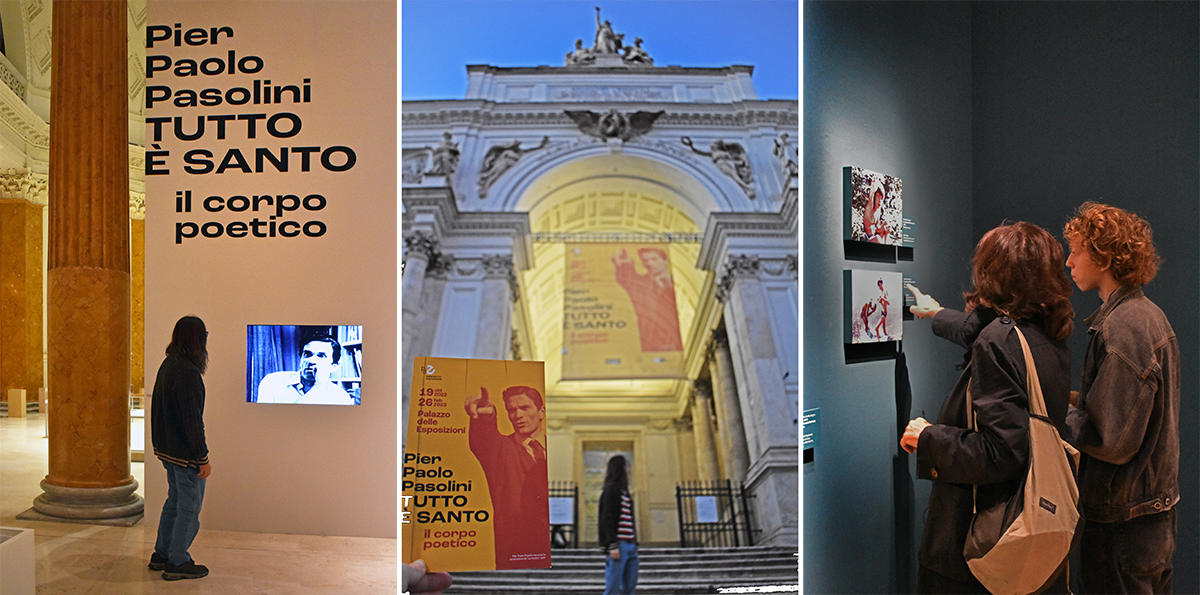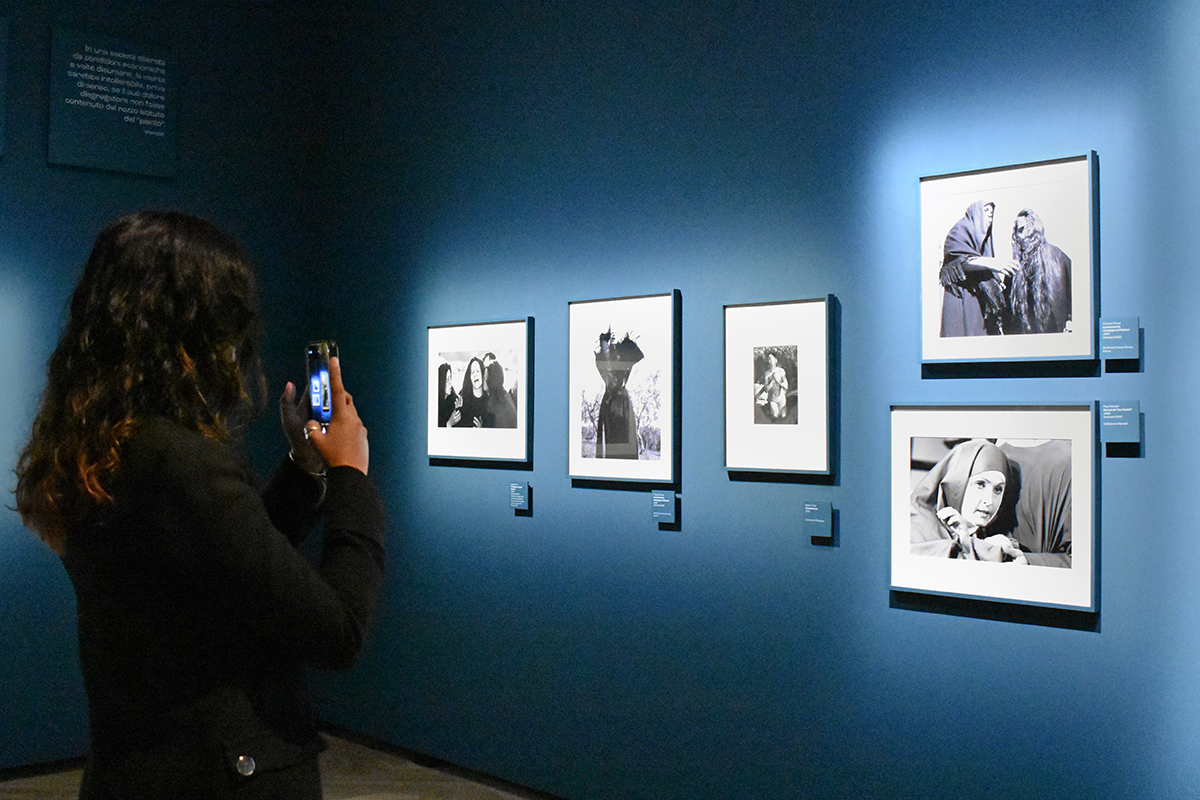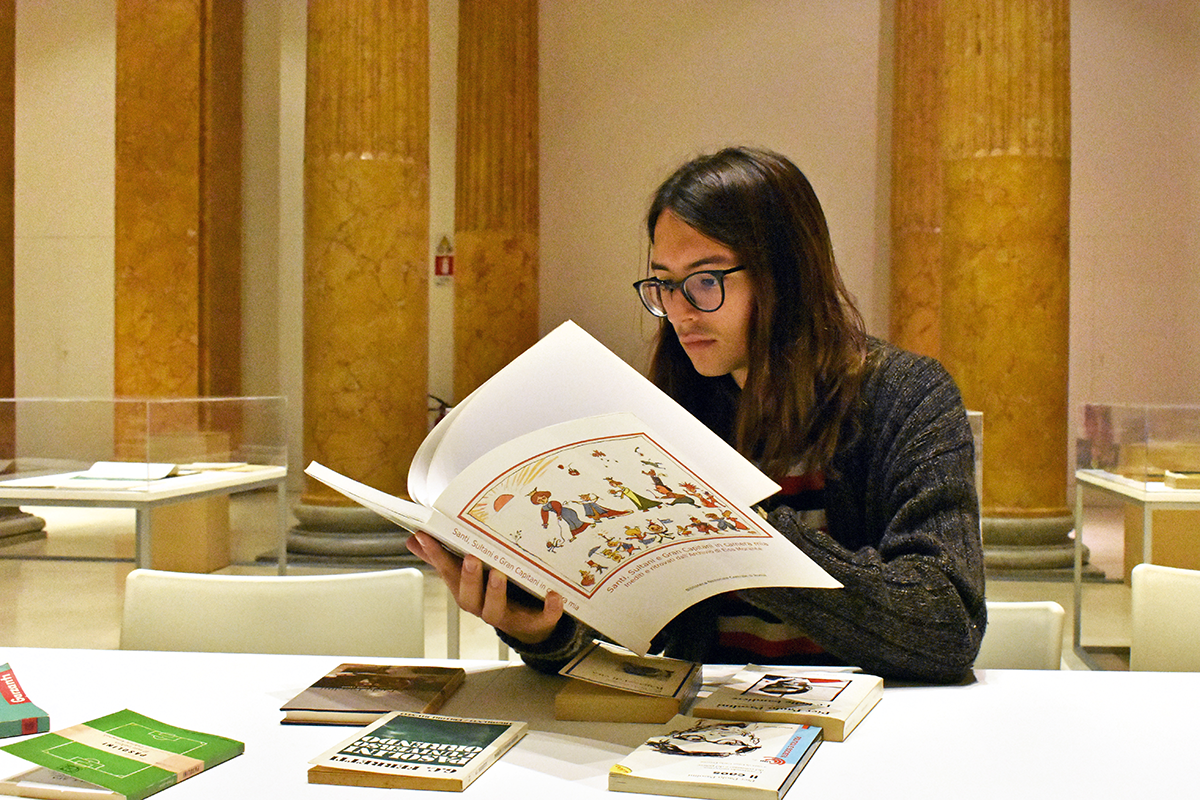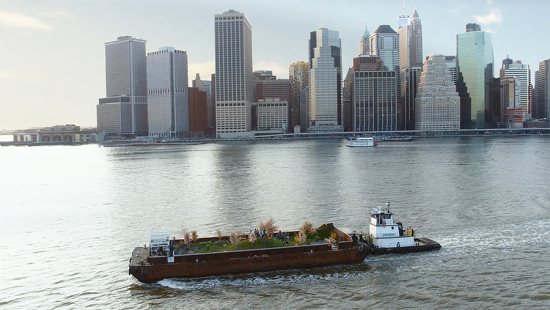Celebrating Pier Paolo Pasolini, Italy's Bard of the Periphery
A giant in postwar Italian literature and film, this semester's Cornell in Rome students dive deep into Pasolini's cross-disciplinary work as the city celebrates his centenary.
 (From left) Oliver Stern (B.F.A. '24) at Azienda Speciale Palaexpo's Pasolini exhibition Pier Paolo Pasolini. Tutto è santo. Corpo poetico; entrance to the Azienda Speciale Palaexpo; Shanti Morrissey (B.F.A. '24) and Professor Carolina Ciampaglia at the Gallerie Nazionali di Arte Antica – Palazzo Barberini's Pasolini exhibition Pier Paolo Pasolini. Tutto è santo. Il corpo veggente. Mia Brown-Seguin (B.F.A. '24) / AAP
(From left) Oliver Stern (B.F.A. '24) at Azienda Speciale Palaexpo's Pasolini exhibition Pier Paolo Pasolini. Tutto è santo. Corpo poetico; entrance to the Azienda Speciale Palaexpo; Shanti Morrissey (B.F.A. '24) and Professor Carolina Ciampaglia at the Gallerie Nazionali di Arte Antica – Palazzo Barberini's Pasolini exhibition Pier Paolo Pasolini. Tutto è santo. Il corpo veggente. Mia Brown-Seguin (B.F.A. '24) / AAPThis year, the centenary of the birth of Italian filmmaker, visual artist, writer, and politically involved intellectual Pier Paolo Pasolini has been celebrated globally, though perhaps with no greater fanfare than in Rome, where events span film festivals, exhibitions, readings, and new publications.
For undergraduate students at the College of Architecture, Art, and Planning studying in Rome this semester, the festivities have presented a particularly inspiring opportunity for a deep dive into Pasolini's creative output. Building on that energy, faculty have designed special coursework to present it collaboratively across classes yet through the lens of their specific areas of expertise.
In Visiting Lecturer Carolina Ciampaglia's art history class focused on Italian film, Pasolini is on the syllabus without exception, she says. "I always include one of Pasolini's first films, Accattone or Mamma Roma, as an example of a type of cinema that chooses a critical position towards the expansion and transformation of Rome during the 1950s and '60s. I also highlight the interplay of classic figurative images and contemporary issues used by Pasolini to evoke the mysterious sacredness of the world of the underclass and the conflict with the new consumeristic, secular world."
 Muskaan Chugh (B.Arch. '24) examining the Pasolini installation at the Gallerie Nazionali di Arte Antica – Palazzo Barberini. Mia Brown-Seguin (B.F.A. '24) / AAP
Muskaan Chugh (B.Arch. '24) examining the Pasolini installation at the Gallerie Nazionali di Arte Antica – Palazzo Barberini. Mia Brown-Seguin (B.F.A. '24) / AAPTaking advantage of the overlap between their class enrollment, Art Professor Michael Ashkin has suggested additional films to his Advanced Photography students as well as Ciampaglia's recommended readings from Stupendous, Miserable City: Pasolini's Rome by John David Rhodes, text that positions Pasolini within urban development in Rome. "Pasolini is not integral to my syllabus," Ashkin notes, pointing out that his is a studio course. "However, the students are walking and photographing in Rome, and it is therefore useful for them to have an understanding not only of its ancient, Medieval, and Renaissance history, but of the transformations that have occurred in this urban landscape since the unification of Italy and the end of World War II. In this sense, Pasolini is useful."
Across the city, a number of additional events allow continued opportunities to explore Pasolini's work, notably the Pier Paolo Pasolini. EVERYTHING IS HOLY exhibition, which is divided across three galleries: Il corpo poetico at the Palazzo delle Esposizioni, Il corpo veggente at the National Gallery of Ancient Art in Barberini Palace, and Il corpo politico at MAXXI.
Ciampaglia's syllabus specifically focuses in on Il corpo veggente, which "explores the decisive role of artistic tradition in Pasolini's cinema and visual imagery, from the Primitives to the Baroque, from the hieratic archaism of Giottesque painters to the subversive realism of Caravaggio, and the theme of the sacred," she says. The students will then attend one or both of the other pieces of the exhibition through their other classes, allowing the faculty to highlight aspects of Pasolini's art related to their course and provide students with multiple perspectives.
 (Clockwise from top left) Abigail Parker-Blier (B.F.A. '24) watching a Pasolini video in Gallerie Nazionali di Arte Antica – Palazzo Barberini; gallery view of the Azienda Speciale Palaexpo's Pasolini exhibition; Oliver Stern (B.F.A. '24) pauses to read more about Pasolini's work. Mia Brown-Seguin (B.F.A. '24) / AAP
(Clockwise from top left) Abigail Parker-Blier (B.F.A. '24) watching a Pasolini video in Gallerie Nazionali di Arte Antica – Palazzo Barberini; gallery view of the Azienda Speciale Palaexpo's Pasolini exhibition; Oliver Stern (B.F.A. '24) pauses to read more about Pasolini's work. Mia Brown-Seguin (B.F.A. '24) / AAPVisiting Critic Anna Gorchakovskaya, who is leading the Contemporary Rome Seminar, helped to organize the EVERYTHING IS HOLY exhibition, particularly Il corpo politico.
"What we quickly realized when we started studying the archive materials and reading Pasolini's text was how extremely timely and relevant his ideas are for contemporary culture," Gorchakovskaya explains. "We tried to show precisely that: the impact Pasolini had on the present moment, the importance and power of his ideas and writings, the way in which contemporary artists engage with the narratives he wove in 1975. The exhibition is meant to present a sort of a constellation of thoughts and images that travel from 1975 straight into our complex present. I would say that it is this quality of Pasolini, this capacity to stay alive and extremely contemporary, that I find most interesting."
Together with Ciampaglia, Gorchakovskaya guided students through the exhibition at Palazzo Barberini. "We were able to have a conversation on cinema, representation, the power of gaze, visibility. Such dialogues help us work in a way that is more interdisciplinary," she says.
Sabine Stock (B.F.A. '24) says that experiencing this celebration of Pasolini’s work has been one of the most meaningful and inspiring elements of her semester in Rome. "Watching his films and reading his poetry deepened my experience of the city," she explains. "He sheds light on a perspective that is lacking from what you are typically presented with as a student abroad in Italy." Visits to the various exhibitions featuring his work "contextualized the art world of Rome and Italy as a whole and stitched together ancient history and the contemporary world. It was galvanizing as a viewer and also as an artist."
 Oliver Stern (B.F.A. '24) explores reading material at Azienda Speciale Palaexpo's Pasolini exhibition. Mia Brown-Seguin (B.F.A. '24) / AAP
Oliver Stern (B.F.A. '24) explores reading material at Azienda Speciale Palaexpo's Pasolini exhibition. Mia Brown-Seguin (B.F.A. '24) / AAPLast semester in Rome, Lecturer Gregory Smith taught the Italian Politics + Planning Workshop, built in part around his recently published book Urban Narratives and the Spaces of Rome: Pier Paolo Pasolini and the City. The book will be released in an Italian edition in March and be presented at the Torino Film Festival as well as at the Mitreo Theatre in Corviale, Rome's most notorious public housing project.
"His foremost aspiration was to empower the disenfranchised in Italy and all over the world," Smith explains, underlining another reason why Pasolini's work remains so salient today. "He was the bard of the poor peripheral parts of Rome and aspired to give a voice to the excluded. He believed that the excluded have a special status in human society, somehow sacred, an enduring witness to genuine humanity. His single most important concept is translinguistics, an operation which can transform our vision of the world, reversing the stigma associated with poverty and exclusion."
In life, Pasolini stood as a complex artist whose vision encouraged his audiences to re-evaluate their understanding of people outside the mainstream and appreciate its subcultures at a time of rapid social change and upheaval. Whether presented on screen or on the page, his work remains a powerful instructor, as relevant today as it was when it was first created.
Stay connected! Follow @cornellaap on Instagram, Facebook, Twitter, and LinkedIn; and subscribe to our AAP bi-weekly newsletter.







